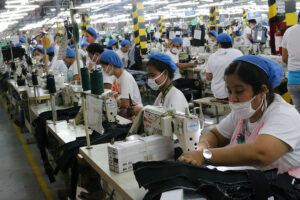Can Philippine manufacturing ever recover?
As there is much talk about the Philippine economy preparing to join Industrial Revolution 4.0 (Artificial Intelligence, Internet of Things, robotics, data science, etc.), there is widespread unease among both local and international economists that the country has not even completed the three previous stages of the industrial revolution, especially those stages in which manufacturing took the lead.

(Part 1)
As there is much talk about the Philippine economy preparing to join Industrial Revolution 4.0 (Artificial Intelligence, Internet of Things, robotics, data science, etc.), there is widespread unease among both local and international economists that the country has not even completed the three previous stages of the industrial revolution, especially those stages in which manufacturing took the lead.
Philippine manufacturing still accounts for such a low percentage of GDP that there is doubt about our really being an industrial nation. Latest data (2023) show that manufacturing as a percentage of GDP in the Philippines is only 16% vs. 24% of Vietnam, 23% of Malaysia, 26% of China, 24% of South Korea, 25% of Thailand, 19% of Indonesia, and 13% of India.
As regards the labor force composition, it is even worse: manufacturing accounts only for 8% of the total labor force. Matters seem to be worsening for Philippine manufacturing as factories leaving China are trooping to other ASEAN countries, especially Vietnam. Our biggest handicaps are very high energy costs, higher wages and inefficient logistics.
As we categorized countries all over the world into levels of development according to their respective per capita incomes, upper middle-income countries — which we are aspiring to become in the next two to three years — have an average percentage of manufacturing to GDP of 22%. It would be reasonable for us to target that level in the next five to 10 years.
What is the possibility of attaining such a goal given prevailing government policies and existing market conditions, both domestically and globally? Will the Luzon Economic Corridor, that the US and Japan are planning to help install, going to reduce our handicaps, especially in the case of chips manufacture? Will our large domestic market finally enable more capital-intensive manufacturing enterprises like vehicle, steel, and chemical production to reach the economies of scale needed to be profitable without huge subsidies from the Government? Will a dramatic increase in the productivity of large-scale growing of agricultural raw materials lead to selling finished food products not only to the large domestic market, made up of mostly young people below 30, but also to the global market as some of our neighboring ASEAN countries, like Thailand, Malaysia, and Vietnam, are already doing?
Before answering these questions, let us clarify some of the important definitions of the various sectors of the economy.
There is the primary sector, i.e., Agriculture, Fisheries and Forestry (AFF). This accounts for 7.7% of GDP. Then there is the secondary sector called Industry which accounts for 26.5% of GDP made up of the sub-sectors Mining (0.7%), Manufacturing (17.7%), Public Utilities (2.8%) and Construction (5.2%). It is worth noting that a country can still be heavily industrialized even if manufacturing does not loom large in terms of GDP as long as the other industrial sectors are contributing significantly to GDP. The preference for manufacturing by most economists is that it has the highest labor productivity and can, therefore, contribute most to increasing the wages of workers.
The biggest contribution to GDP is from the so-called Tertiary sector, Services, which account for 54.9% of GDP, led by Wholesale and retail and repair of motor vehicles and motorcycles (14.4%), Financial services (10.2%), and Professional and business services (5.2%).
The two largest contributors to GDP (together making up 20% of GDP) are OFW remittances and business process outsourcing-information technology (BPO-IT) which are predominantly part of the Service sector. In fact, there are those who do not worry about the low level of manufacturing in the Philippines and maintain we can leapfrog into becoming a predominantly service economy, especially if we take seriously our transformation into the digital economy that Industrial Revolution 4.0 connotes.
We shall see, however, later in this discussion that because of our large and growing population and our rich natural resources, it would be unwise for us to skip the first three stages of the industrial revolution that most large nations had to traverse over the last 200 years, starting with England that experienced the first ever industrialization revolution (Industrial Revolution 1.0).
Even small territories that are part of the First World today like Singapore, Hong Kong, and Taiwan, had to start with manufacturing on their road to becoming highly industrialized economies. In the first decade or so after the Second World War, these territories (together with South Korea) capitalized on their demographic dividends back then by establishing labor-intensive, export-oriented factories producing textiles, garments, toys, furniture, and other consumer products for the rich markets of the US and Europe. In that way, they laid the foundation for more capital- and technology-intensive manufacturing enterprises in their later stages of industrialization. This enlightened strategy helped them reach full employment of their labor force and simultaneously imbibed among their workers an industrial culture. Furthermore, they were able to earn the foreign exchange that they badly needed to import what they could not produce locally. It is no coincidence that these four economic territories became famous as the East Asian tigers of the last decades of the 20th century.
In contrast, the Philippines followed the opposite path of inward-looking import-substitution and capital-intensive industrialization which kept the vast majority of the working population in low-productivity farming and services. The results were high rates of unemployment, and especially underemployment, and thus very high poverty incidences.
Collateral damage inflicted by the slow growth of manufacturing was that it took much longer for Filipino workers to transition from a rural to an industrial culture. The higher growth rate of the Philippine population back then did little to help the country match the economic growth and industrial progress of its East Asian neighbors. It was not the growing population, however, that was the problem. It was the failure of the government leaders to take advantage of the demographic dividend by encouraging the private sector to invest in the appropriate labor-intensive, export-oriented industries and to give the highest priority to developing the agricultural sector.
These preliminary insights into our lackluster industrial history should already explain to a great extent our present difficulties in improving the share of manufacturing to our total GDP.
At this juncture, I would like to state that in subsequent columns I will be quoting copiously from a blog on the internet posted on Sept. 15, 2018 by Eric Howard entitled “The Evolution of the Industrial Ages: Industry 1.0 to 4.0.” It encapsulates for the lay person a whole semester on Economic History that I took under famous Harvard Economics professor Alexander Gerschenkron (1904-1978). I was very fortunate to have learned economic history from this pioneer of quantitative New Economic history who was considered the doyen of economic history in the US.
It would be worthwhile reflecting on the stages of the so-called Industrial Revolution to understand better how the Philippines “missed the boat” because our leaders during the first half century of our independent national development decided to plunge head into what they considered industrialization without first completing some of the pre-requisites to sustainable industrial development of a large nation like ours. As we shall see in subsequent columns, the gravest mistake we made was to try to industrialize without first completing the green or agricultural revolution that preceded the first ever industrialization that happened in England during the period 1770 to 1840. That is why at this late stage of our development, we are still talking about attaining food security and lamenting the very high rate of hunger among our population, especially among the hapless children.
I dedicate this part of this series of articles to the memory of my Harvard professor, Alexander Gerschenkron.
(To be continued.)
Bernardo M. Villegas has a Ph.D. in Economics from Harvard, is professor emeritus at the University of Asia and the Pacific, and a visiting professor at the IESE Business School in Barcelona, Spain. He was a member of the 1986 Constitutional Commission.























